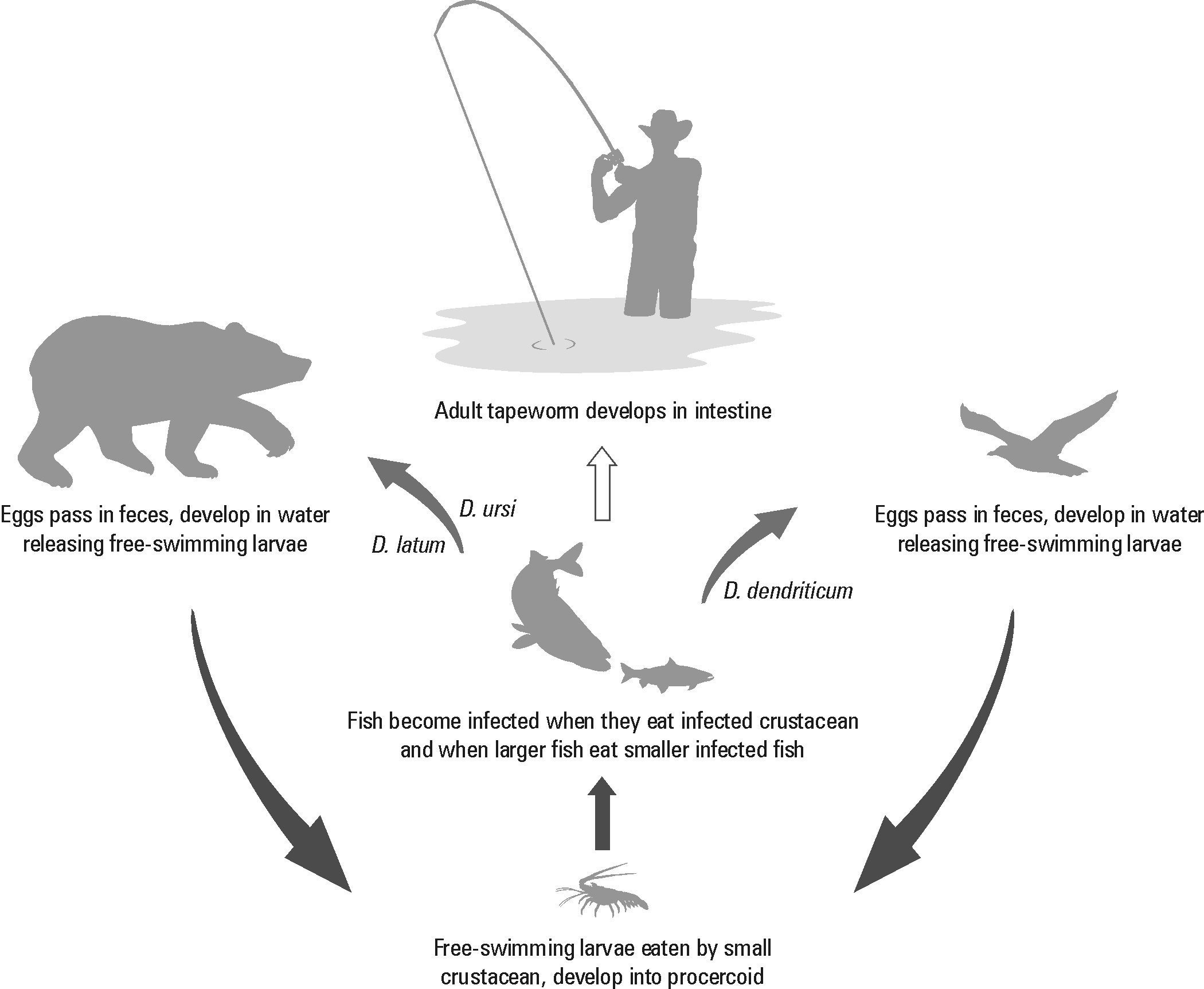| | Life cycle | How common is fish tapeworm? | Can I see the larvae in fish? | What harm do they cause? | How can I know if I have tapeworms? | How can I prevent getting broad tapeworm?
Many parasites infect fish, but only a few such as the broad tapeworm, Diphyllobothrium spp., occasionally infect man. The larval stage of these parasites develops in fish while the adults develop in various fish-eating mammals, marine mammals or fish-eating birds.
The best known species in this group, D. latum, is the longest tapeworm in man, reaching a length of 10 meters. This parasite is found worldwide and is common in countries where raw or undercooked fish is eaten.
Life Cycle
The life cycle of the D. latum tapeworm consists of three obligatory hosts: a mammal, a copepod and a fish (Figure 1).
- The adult tapeworm attaches to the small intestine of man, matures and sheds eggs that pass in the feces.
- The egg continues its development in water, eventually producing a ciliated embryo, called a coracidium, which hatches and becomes free-swimming.
- When the free-swimming coracidium is eaten by a small crustacean (a copepod), it develops into a procercoid larva that is now capable of infecting fish.
- When plankton-feeding fish eat infected copepods, the procercoid is released and develops into another larva, called a plerocercoid that migrates to the muscle or visceral organs of the fish.
The life cycle can be extended to include other fish, which occurs when larger fish eat the smaller infected fish. When this situation occurs, the plerocercoid re-establishes in the larger predatory fish. The process may repeat itself, resulting in many larvae accumulating in the biggest fish.
- Humans acquire the parasite by eating raw or poorly cooked fish containing plerocercoids. The parasite can grow to 10 meters in length, produce over 1 million eggs a day and live for several years. Other species of Diphyllobothrium are generally smaller and do not live as long in humans.

How Common is the Fish Tapeworm?
Infections are mainly confined to regions where fish is eaten raw, marinated or undercooked. The parasite can be common in some communities in Alaska and Canada, and rare or absent in others.
Several species of Diphyllobothrium occur in fish. The species most likely to infect people of a particular region will depend on the fish they consume. Diphyllobothrium latum occur in pike, walleye and perch; Diphyllobothrium dendriticum occur primarily in whitefish and salmonids, including arctic char and trout.
Can I See the Larvae in Fish?
D. latum is not easily seen in fish because the plerocercoids lie unencysted in fish muscle. Some species, such as
D. dendriticum, encyst within the viscera of the fish attached to the stomach, liver, gonads or intestine.
However, if the fish is left for some time, the plerocercoid may emerge from its cyst and migrate into the muscle, making the parasite more difficult to find.
What Harm do They Cause?
D. latum is the most common cause of diphyllobothriasis in man. Usually only one or two tapeworms are present, but up to 200 worms have been reported.
People infected with only a few worms may have no symptoms. If several tapeworms are present, the infected person may experience non-specific symptoms including nausea, abdominal discomfort, diarrhoea and vomiting.
The lesions produced by migrating plerocercoids may kill fingerlings or young adult fish. The effect of other species of Diphyllobothrium on their hosts has not been studied extensively.
How Can I know if I Have Tapeworms?
Diagnosis is based on recovering eggs or portions of the tapeworm in a stool sample.
How Can I Prevent Getting Broad Tapeworm?
- Do not eat raw or undercooked fish from infected lakes.
- Freeze fish at -10°C for 24 hours.
- Cook fish to 54 to 56°C for 5 minutes or until cooked throughout.
- Clean fish immediately after catching; do not feed fresh fish or viscera to your dog or other pets.
- Marinating or lightly pickling fish will not kill all the plerocercoid.
Prepared by:
Murray J. Kennedy, Ph.D.
Food Safety Division
Source: Agdex 485/655-11. August 2005. |
|